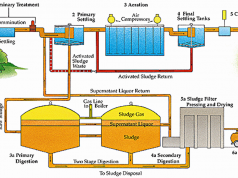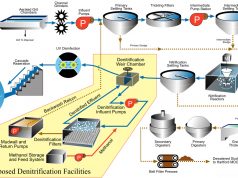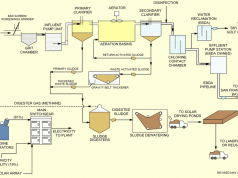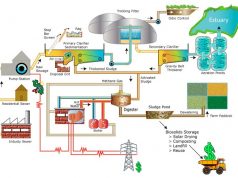 Biotechnology is technology based on biology, especially when used in agriculture, food science, and medicine. The United Nations Convention on Biological Diversity defines biotechnology as:[1]
Biotechnology is technology based on biology, especially when used in agriculture, food science, and medicine. The United Nations Convention on Biological Diversity defines biotechnology as:[1]
Any technological application that uses biological systems, living organisms, or derivatives thereof, to make or modify products or processes for specific use.
Cn sinh học là ngành công nghệ dựa trên sinh học , đặc biệt khi được sử dụng trong nông nghiệp,khoa học thực phẩm và thuốc .Hội nghị liên hiệp quốc về đa dạng sinh học đã định nghĩa về ngành này:bất cứ công nghệ ứng dụng sử dụng hệ thống sinh học,sinh vật sống hoặc bắt nguồn từ đó,làm những sản phẩm biến đổi hay các quá trình cho việc sử dụng đặc biệt
Biotechnology is often used to refer to genetic engineering technology of the 21st century, however the term encompasses a wider range and history of procedures for modifying biological organisms according to the needs of humanity, going back to the initial modifications of native plants into improved food crops through artificial selection and hybridization. Bioengineering is the science upon which all biotechnological applications are based. With the development of new approaches and modern techniques, traditional biotechnology industries are also acquiring new horizons enabling them to improve the quality of their products and increase the productivity of their systems.
cnsh thường đc sử sụng để liên hệ tới công nghệ gene cuả thế kỉ 21.Mặc dù vâỵ , cái từ đó bao hàm một diện rộng và lịch sử cuả thủ tục trong việc sưả đỗi các cơ quan sinh học theo nhu cầu cuả con ngươì.Quay về vơi sự sưả đổi ban đâù cuả thực vật tự nhiên trong để cải tiến các loại thực phẩm thông qua các lưạ chọn nhân tạo và sự lai giống. Các vận dụng cuả công nghệ sinh dưạ trên kỉ thuật sinh học .Vơí sự phát triển cuả những bước phát triển mới và kĩ thuật hiện đaị , ngành công nghệ sinh truyền thống đang đạt được những tầm hiểu biết mới cho phép nó cải tiến chất luợng sản phẩm và tăng năng suất ơí sự phát triên3 cuả những bước phát triển mo81i và kĩ thuật hiện đaị , ngành công nghệ sinh truyền thống đang yêu cầu những chân trời mới cho phép nó cải tiến chất luợng sản phẩm và tăng năng suất
Before 1971, the term, biotechnology, was primarily used in the food processing and agriculture industries. Since the 1970s, it began to be used by the Western scientific establishment to refer to laboratory-based techniques being developed in biological research, such as recombinant DNA or tissue culture-based processes, or horizontal gene transfer in living plants, using vectors such as the Agrobacterium bacteria to transfer DNA into a host organism. In fact, the term should be used in a much broader sense to describe the whole range of methods, both ancient and modern, used to manipulate organic materials to reach the demands of food production. So the term could be defined as, “The application of indigenous and/or scientific knowledge to the management of (parts of) microorganisms, or of cells and tissues of higher organisms, so that these supply goods and services of use to the food industry and its consumers.
Trước năm 1971, từ công nghệ sinh học xuất phát từ nguyên thuỷ là các quá trình chế biến thực phẩm và nông nghiệp.Kể từ những năm 1970 nó được sử dụng bởi sự thành lập cuả khoa học phương Tây liên quan đến những công nghệ trong phòng thí nghiệm được phát triển trong nghiên cứu khoa học , như kĩ thuật chuyển gen hay quá trình cấy mô hoặc tầm hiểu biết mới về gene vận chuyển trong thực vật sống , sử dụng các vector như vi khuẩn Agrobacterium để chuyển DNA vào tế bào chủ .Trên thực tế, từ đó cần được sử dụng trong nhận thức rộng hơn để miêu tả toàn bộ phạm vi cuả các phương pháp trên , cả cổ xưa lẫn hiện đại, được sử dụng để biến đổi các nguyên liệu hữu cơ đáp ứng yêu cầu sản xuất thực phẩm , vì vậy từ cnsh có thể được định nghiã như“sự áp dụng những kiến thức khoa học trong việc quản lý vi sinh vật hay các tế bào, các mô cuả các cơ quan lơn hơn, với mục đích cung cấp những sản phẩm cuả nó và phục vụ ngành công nghiệp thực phẩm cũng như ngươì tiêu dùng. “
Biotechnology combines disciplines like genetics, molecular biology, biochemistry, embryology and cell biology, which are in turn linked to practical disciplines like chemical engineering, information technology, and robotics. Patho-biotechnology describes the exploitation of pathogens or pathogen derived compounds for beneficial effect.
Cnsh kết hợp tính nguyên tắc trong di truyền , sinh học phân tử , sinh hoá , phôi học và sinh học tế bào ,và đến lượt nó lại liên kết với các nguyên tắc thực hành trong công nghệ hoá,công nghệ thông tin và robot.Công nghệ sinh học thể sinh bệnh miêu tả sự khai lợi cuả thể sinh bệnh hoặc hợp chất tìm thấy nguồn gốc từ thể sinh bệnh cho những ảnh hưởng có lọi cho chúng
ry
Brewing was an early application of biotechnologyMain article: History of Biotechnology
The most practical use of biotechnology, which is still present today, is the cultivation of plants to produce food suitable to humans. Agriculture has been theorized to have become the dominant way of producing food since the Neolithic Revolution. The processes and methods of agriculture have been refined by other mechanical and biological sciences since its inception. Through early biotechnology, farmers were able to select the best suited and highest-yield crops to produce enough food to support a growing population. Other uses of biotechnology were required as crops and fields became increasingly large and difficult to maintain. Specific organisms and organism by-products were used to fertilize, restore nitrogen, and control pests. Throughout the use of agriculture, farmers have inadvertently altered the genetics of their crops through introducing them to new environments and breeding them with other plants–one of the first forms of biotechnology. Cultures such as those in Mesopotamia, Egypt, and Pakistan developed the process of brewing beer. It is still done by the same basic method of using malted grains (containing enzymes) to convert starch from grains into sugar and then adding specific yeasts to produce beer. In this process the carbohydrates in the grains were broken down into alcohols such as ethanol. Ancient Indians also used the juices of the plant Ephedra vulgaris and used to call it Soma. Later other cultures produced the process of Lactic acid fermentation which allowed the fermentation and preservation of other forms of food. Fermentation was also used in this time period to produce leavened bread. Although the process of fermentation was not fully understood until Louis Pasteur’s work in 1857, it is still the first use of biotechnology to convert a food source into another form.
Sự sử dụng thiết thực nhất cuả cnsh, vẫn còn hiện diện cho đến ngày nay là trồng trọt cây cối sản xuất thực phẩm dành cho con người.Nông nghiệp nói 1 cách lý thuyết đã trở thành một cách quan trọng để sản xuất thực phẩm kể từ thời đồ đá mới.Quá trình và phương pháp nông nghiệp đã được chọn lọc,cải tiến dần bời khoa học về máy móc và sinh học kể từ sự bắt đầu cuả nông nghiệp.Qua cnsh lúc mới bắt đầu, người nông dân có thể lưạ chọn sản lượng hoa lợi thích hợp nhất và cao nhất, sản xuất đủ lượng thực phẩm đáp ứng sự tăng nhanh về dân số .Những sự sử dụng khác cuả cnsh đã được yêu cầu như sự rộng lớn và khó khăn để duy trì ngày càng tăng .Những sinh vật đặc biệt và sản phẩm sinh vật được dùng để làm màu mỡ,phục hồi nitrogen và điều khiển những sinh vật gây hại.Trong suốt quá trình làm nông,ngưởi nông dân đã tình cờ thay đổi tính di truyền cuả nhiều cây trồng qua việc đưa chúng vào những môi trường mới và gây giống với những cây trồng khác-một trong những hình thức đầu tiên cuả cnsh.Nông nghiệp ở 1 số nước Mesotamia,Ai Cập và pakitxtan đã phát triển quá trình ủ bia.Nó vẫn còn được làm bởi cùng phương pháp cơ bản cuả viễc sử dụng mạch nha (chứa enzym) để biến đổi tinh bột trong luá gạo thành đường và sau đó thêm vào những loại men đặc biệt để sản xuất bia.Trong quá trình này các cacbonhydrat bị bẽ gãy trở thành rươụ như ethanol.Những người Ấn độ cổ đại cũng sử dụng nước ép cây ma hoàng và gọi nó là Soma.Sau đó xuất hiện quá trình lên men từ acid lactic cho phép lên men và bảo quản thực phẩm.Quá trình lên men cũng được sử dụng trong thời gian này để làm men bánh mỳ.Quá trình lên men chỉ thực sự được hiểu thấu đáo cho đến thời cuả Lui Paxtơ vào năm 1857, nó vẫn còn là dạng ban đầu cuả cnsh ,biến đổi thực phẩm thành các dạng khác
Combinations of plants and other organisms were used as medications in many early civilizations. Since as early as 200 BC, people began to use disabled or minute amounts of infectious agents to immunize themselves against infections. These and similar processes have been refined in modern medicine and have led to many developments such as antibiotics, vaccines, and other methods of fighting sickness.
Sự kết hợp cuả các loại cây trồng và các loài sinh vật khác được sủ dụng như những phương thuốc trong các nền văn minh lúc xưa.Kể từ 200 năm trước công nguyên , con người bắt đầu sử dụng những tác nhân gây bệnh bị yếu đi hay với số lượng it để gây miễn dịch với các tác nhân gây bệnh đó.Những cái đó và những quá trình tương tự đã được cải tiến trong y học hiện đại và dẫn đến nhiều sự phát triển như thuốc kháng sinh ,vắc xin và những phương pháp khác để chống lại bệnh tật
In the early twentieth century scientists gained a greater understanding of microbiology and explored ways of manufacturing specific products. In 1917, Chaim Weizmann first used a pure microbiological culture in an industrial process, that of manufacturing corn starch using Clostridium acetobutylicum to produce acetone, which the United Kingdom desperately needed to manufacture explosives during World War I.[3]
Vào đầu thế kỉ XX cái nhà khoa học đã nâng hiểu biết về vi trùng học và khảo sát những kiểu sản xuất thực phẩm đặc biệt.Vào năm 1917,Chaim Weizmann lần đầu tiên sử dụng các kiến thức về vi trùng trong quá trình sản xuất công nghiệp , chế biến tinh bột bắp bằng cách sử dụng vi khuẩn Clostridium acetobutylicum để sản xuất acetone,hoá chất mà nước Mỹ rất cần để sản xuất thuốc nổ trong chiến tranh thế giới thứ I
The field of modern biotechnology is thought to have largely begun on June 16, 1980, when the United States Supreme Court ruled that a genetically-modified microorganism could be patented in the case of Diamond v. Chakrabarty.[4] Indian-born Ananda Chakrabarty, working for General Electric, had developed a bacterium (derived from the Pseudomonas genus) capable of breaking down crude oil, which he proposed to use in treating oil spills.
Lĩnh vực cnsh hiện đại được xem là bắt đầu rộng rãi từ ngày 16/6/1980, khi toà án tối cao cuả hoa kỳ ra luật lệ là những biến đổi tính di truyền cuả vi sinh vất có thể được cấp bằng như trong trường hợp cuả Diamond v. Chakrabarty , sinh ra tại Ấn Độ , làm việc cho nhà máy điện , đã phát triển khả năng cuả vi khuẩn có thể crăcking dầu thô, và anh đề nghị sử dụng nó để chế biến dầu
Revenue in the industry is expected to grow by 12.9% in 2008. Another factor influencing the biotechnology sector’s success is improved intellectual property rights legislation — and enforcement — worldwide, as well as strengthened demand for medical and pharmaceutical products to cope with an ageing, and ailing, U.S. population.[5]
Thu nhập trong công nghiệp được mong đợi sẽ tăng lên tới 12,9% trong năm 2008.Một nhân tố khác đang ảnh hưởng tới sự thành công của ngành cnsh là luật về quyền sở hữu trí tuệ đã đc cải thiện-sự thúc đẩy cái ngành này lan rộng ra toàn thế giới cùng với sự tăng cường những nhu cầu về thuốc và sản phẩm dược để đối phó với bệnh tật ,tuổi tác và dân số nước mỹ
Rising demand for biofuels is expected to be good news for the biotechnology sector, with the Department of Energy estimating ethanol usage could reduce U.S. petroleum-derived fuel consumption by up to 30% by 2030. The biotechnology sector has allowed the U.S. farming industry to rapidly increase its supply of corn and soybeans — the main inputs into biofuels — by developing genetically-modified seeds which are resistant to pests and drought. By boosting farm productivity, biotechnology plays a crucial role in ensuring that biofuel production targets are met.[6]
Sự gia tăng nhu cầu về nhiên liệu sinh học được mong đợi trở thành 1 tin tốt cho lãnh vực cnsh , với sự ước lượng về việc sử dụng ethanol của uỷ ban năng lượng đã có thể giảm lượng nhiên lấy từ nguồn dầu mỏ cuả mỹ tới 30% trong năm 2030. Lĩnh vực cnsh đã cho phép ngành công nghiệp nông nghiệp mỹ nhanh chóng gia tăng nguồn cung cấp về ngô và đậu nành -nguyên liệu chính để sản xuất nhiên liệu sinh học -bằng cách phát triển việc biến đổi hạt giống có sức chống chịu với các loài gây hại và hạn hán . Bằng cách gia tăng năng suất cây trồng , cnsh giữ 1 vai trò cốt yếu trong việc bảo đảm việc sản xuất nhiên liệu sinh học được đáp ứng
Biotechnology has applications in four major industrial areas, including health care (medical), crop production and agriculture, non food (industrial) uses of crops and other products (e.g. biodegradable plastics, vegetable oil, biofuels), and environmental uses.
Cnsh có những ứng dụng trong 4 phần quan trọng của công nghiệp , bao gồm chăm sóc sức khỏe , sản xuất lương thực và nông nghiệp, sử dụng những thứ phi thực phẩm từ cây trồng và những sản phẩm khác( ví dụ như nhựa tự phân hủy ,dầu thực vật,nhiên liệu sinh học ) và việc sử dụng môi trường
For example, one application of biotechnology is the directed use of organisms for the manufacture of organic products (examples include beer and milk products). Another example is using naturally present bacteria by the mining industry in bioleaching. Biotechnology is also used to recycle, treat waste, clean up sites contaminated by industrial activities (bioremediation), and also to produce biological weapons.
Cho ví dụ , 1 ứng dụng cuả cnsh là việc sử dụng trực tiếp các sinh vật cho việc sản xuất các sản phẩm hữu cơ (ví dụ bia và các sản phẩm sưã ).Ví dụ khác nưã là việc sử dụng vi khuẩn trong việc lọc sinh học ở ngành công nghiệp khai mỏ .Cnsh cũng được sử dụng để tái sử dụng , xử lý chất thải , dọn sạch những chỗ bị ô nhiễm bởi hoạt động công nghiệp và cũng để sản xuất ra vũ khí sinh học
A series of derived terms have been coined to identify several branches of biotechnology, for example:
Một chuỗi những thuật ngữ đã được đặt ra để xác định các nhánh cuả ngành cnsh , ví dụ như:
Red biotechnology is applied to medical processes. Some examples are the designing of organisms to produce antibiotics, and the engineering of genetic cures through genomic manipulation.
Cnsh đỏ được ứng dụng cho các quá trình chăm sóc sức khoẻ . Một vài ví dụ là sự phác hoạ về những sinh vật sản xuất các kháng thể , và kĩ thuật chưã bệnh di truyền thông qua thao tác với bộ gen
A rose plant that began as cells grown in a tissue cultureGreen biotechnology is biotechnology applied to agricultural processes. An example would be the selection and domestication of plants via micropropagation. Another example is the designing of transgenic plants to grow under specific environmental conditions or in the presence (or absence) of certain agricultural chemicals. One hope is that green biotechnology might produce more environmentally friendly solutions than traditional industrial agriculture. An example of this is the engineering of a plant to express a pesticide, thereby eliminating the need for external application of pesticides. An example of this would be Bt corn. Whether or not green biotechnology products such as this are ultimately more environmentally friendly is a topic of considerable debate.
Cây hoa hồng bắt đầu như những tế bào trưởng thành trong cnsh câý mô thực vật là cnsh được ứng dụng vào các quá trình nông nghiệp.Một ví dụ sẽ là sự lưạ chọn và sự thuần hoá cây trồng từ sự nhân giống cực nhỏ.Ví dụ khác là sự sáng tạo nên các thực vật chuyển gen tăng trưởng dưới điều kiện môi trường đặc biệt hoặc trong sự hiện diện(hay vắng mặt) cuả các hoá chất nông nghiệp .Một hy vọng là cnsh xanh phải sản xuất ra những cái thân thiện với môi trường hơn ngành công nghiệp nông nghiệp truyền thống .Một ví dụ cuả việc này là kĩ thuật tạo nên một loài cây có khả năng tự tạo ra thuốc trừ sâu .Ví dụ như bắp Bt.Có hay không những sản phẩm cnsh xanh như vậy thì thân thiện với môi trường hơn là 1 chủ đề tranh luận đáng bàn
White biotechnology, also known as industrial biotechnology, is biotechnology applied to industrial processes. An example is the designing of an organism to produce a useful chemical. Another example is the using of enzymes as industrial catalysts to either produce valuable chemicals or destroy hazardous/polluting chemicals. White biotechnology tends to consume less in resources than traditional processes used to produce industrial goods.
CNSH trắng cũng được biết đến như là ngành công nghiệp cnsh, là cnsh ứng dụng vào các quá trình công nghiệp .Một ví dụ là sự thiết kế các sinh vật sản xuất những hợp chất hoá học hữu ích .Ví dụ khác là việc sử dụng các enzyme như những chất xúc tác công nghiệp đến việc sản xuất các hoá chất có giá trị hay việc tiêu huỷ các chất ô nhiễm /nguy hiểm .Cnsh trắng có xu hướng sử dụng it1 các nguồn tài nguyên hơn những quá trình truyền thống được sử dụng để sản xuất hàng hoá công nghiệp
Blue biotechnology is a term that has been used to describe the marine and aquatic applications of biotechnology, but its use is relatively rare.
Cnsh xanh dương là một thuật ngữ được dùng để miêu tả những gì ở biển và ứng dụng dưới nước cuả cnsh , nhưng sự sử dụng nó thì tương đối hiếm
The investments and economic output of all of these types of applied biotechnologies form what has been described as the bioeconomy.
Bioinformatics is an interdisciplinary field which addresses biological problems using computational techniques, and makes the rapid organization and analysis of biological data possible. The field may also be referred to as computational biology, and can be defined as, “conceptualizing biology in terms of molecules and then applying informatics techniques to understand and organize the information associated with these molecules, on a large scale.”[7] Bioinformatics plays a key role in various areas, such as functional genomics, structural genomics, and proteomics, and forms a key component in the biotechnology and pharmaceutical sector.
Sự đầu tư và sự sản xuất kinh tế cuả tấtcả các loại cnsh ứng dụng đã được miểu tả như nền kinh tế sinh học . Sinh tin học là một lĩnh vực gồm nhiều ngành học thuật nói tới những vấn đề sinh học sử dụng công nghệ về máy tính , và làm nên sự cấu tạo nhanh chóng sự phân tích các dữ liệu sinh học .Lĩnh vực này cũng quy thành sinh học thuộc về máy tính ,và có thể được định nghiã như:” Sinh học được khái niệm hoá trong các thuật ngữ về phân tử và sau đó cung cấp thông tin kỹ thuật để hiểu và tổ chức thông tin liên quan tới những phân tử này , trên một quy mô rộng lớn ” Sinh tin học giữ vai trò chià khoá trong các lĩnh vực khác nhau ,như chức năng gene,cấu trúc gene và sự chuyển hoá protein , và hình thành chià khoá cấu thành trong cnsh và lĩnh vực thuốc men








